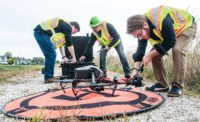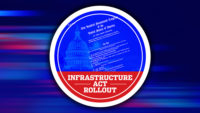The Trump administration is launching a pilot program that seeks to expand the use of aerial drones, a move that could increase that spread of the aircraft in the construction industry.
President Trump signed a memorandum on Oct. 25 that directs the U.S. Department of Transportation to set up the new test program, approving arrangements with at least five states, localities or tribal groups that submit proposals for wider use of unmanned aerial systems, or UAS.
U.S. DOT said that infrastructure inspections and monitoring are among the industries that “could see immediate opportunities” from the pilot program.
DOT said the new pilot program will study such now-generally-prohibited activities as nighttime drone operations, flights over people and beyond the operator’s line of sight.
John Palatiello, executive director of surveying and geospatial information group MAPPS, says, “Those are two of the most significant barriers right now to using UAS for geospatial data acquisition.” He adds, “So the faster the federal government can develop regulations to enable those kinds of activities, the better it will be for the geospatial community.”
The Federal Aviation Administration, which is part of U.S. DOT, said in a report released in March 2017 that construction, industrial and utility inspection accounts for 26% of total drone uses, the same percentage as the real estate sector. Only aerial photography has a greater share of U.S. usage, 34% of the total.
A March 2016 American Association of State Highway and Transportation Officials report said that 17 state DOTs had either used or researched drones for such tasks as bridge inspections and 16 are considering employing such aircraft for some activities.
The presidential directive says, “Well-coordinated integration of UAS into the national airspace system (NAS) alongside manned aircraft will increase the safety of the NAS and enable the authorization of more complex UAS operations.”
U.S. DOT and FAA will set up the program by late January—within 90 days of the Trump memorandum. Within 180 days after that, the department would enter into agreements with the state and local agencies or other parties. The drone test program is to last three years, unless the DOT secretary decides to extend it.
FAA last year issued a rule setting limits on commercial use of small drones—those weighing less than 55 lb. Pilots of such aircraft, the kind most commonly used in engineering and construction, must be registered with the FAA and pass an aeronautical knowledge test.
Besides keeping the UAS within their lines of sight, operators must fly the devices at altitudes lower than 400 ft. and only during daylight hours, and not over people.
Palatiello says states or localities also might propose looking at "the integration of UAS into air traffic control near an airport." Drone use around airports now is very, very limited," he notes.
Palatiello adds, "Airports themselves are going to be a huge market, for master planning, for [detecting] obstructions to navigation, for a variety of different applications. So to be able to fly a UAS over or around an airport in a manner that does not in any way jeopardize the safety of a commercial aircraft or other aircraft in that airspace, that's going to be a very important issue to resolve."
Allowing multiple state or local jurisdictions to set aerial drone regulations conceivably could lead to differing requirements around the U.S. But DOT Secretary Elaine Chao said in a statement, “As this program is implemented, we must ensure that federal authority over our airspace is maintained to protect against a burdensome and complicated patchwork of local rules that could impede the full implementation of this innovative technology.”
Senate Commerce, Science and Transportation Committee Chairman John Thune (R-S.D.) said in a statement that the new memorandum “provides sensible direction that promotes drone safety, innovation and local input.”
Thune added, “Federal management of air operations has underpinned a long history of steady safety improvements in our skies. This presidential memorandum is another step in the right direction.”
The FAA issued a forecast in March saying that the U.S. commercial drone fleet will climb more than tenfold over the next five years, to about 442,000, with an “upside possibility” that it could reach 1.6 million.





Post a comment to this article
Report Abusive Comment